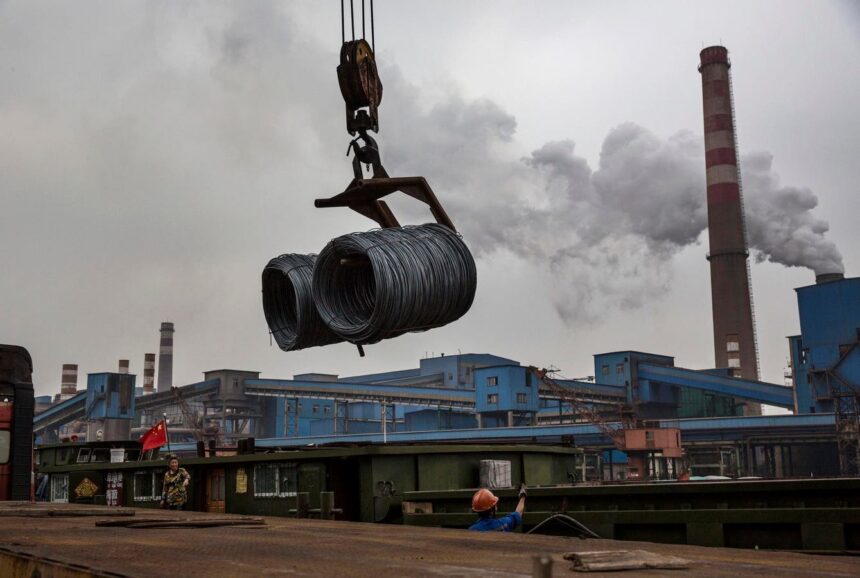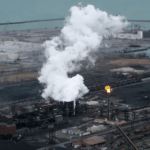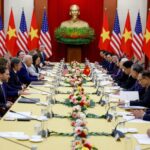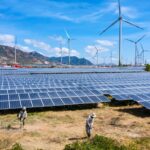According to a brand-new Globe Financial institution evaluation, the Oriental commercial field has $1.7 trillion in tidy financial investment chances – doing so might lower international carbon discharges by 16% by 2023.
Topshot – An employee strolled previous liquified steel at a steel plant in Huai’an, Jiangsu District, eastern China on July 22, 2025.
AFP using Getty Photos
Sector– Making the items we make use of everyday, from steel to seal to garments– discharge one-third of all human-caused environment air pollution. In China, Indonesia and Vietnam, the power and commercial industries make up 75% -87% of all energy-related discharges.
However a brand-new front runner record from the Globe Financial institution, co-authored by Power Technology, discovered that just $70 billion each year spent, comparable to 0.3% of the GDP of these nations might attain decarbonization of production by 2050 in the cleansing sector.
Brand-new record, Industrial decarbonization I nEast Asia: Adjustments in power, money, modern technology and job is a detailed roadmap for innovations anticipated to be made throughout East Asia.
Production that transforms resources right into assets is East Asia’s biggest power customer and resource of greenhouse gas discharges. Regardless of its value, the sector has actually not gotten self-confidence in the international power shift, however the record exposes opportunities for decarbonization. Changing production can take on brand-new innovations and chances to create the residential economic situation by spending wisely in contemporary and effective commercial procedures. If these 3 nations utilize this approach, they will certainly lower international discharges by around 6 billion lots of co2 matching.
And chances are not restricted to East Asia: the exact same technological and plan manuscripts can aid economic climates around the globe sign up with the Tidy Industrial Transformation.
The job of tidying up the sector
The Globe Financial institution record takes into consideration exactly how commercial manufacturing will certainly alter without brand-new plans being applied, after that ordered on the effectiveness and decarbonization modern technology of the six-layer. Technologies that enhance power effectiveness, product effectiveness and item life make up the biggest share of power cost savings and discharges minimized by China and Vietnam, and the 2nd biggest share in Indonesia.
The “easy” electrification choices (consisting of straight electrification of cryogenic commercial warmth, changing diesel motor with electrical motors, and partly moved from key to reusing of steel production – are the following top priority. Succeeding technological layers consist of straight electrification in addition to carbon capture and storage space, use tidy hydrogen, and more chances for utilizing tidy chemical feedstocks.
In China, Indonesia and Vietnam, discharges decreases in the modern technology layer are a portion. Because carbon capture (layer 3) records just 90% of co2, there is a 3-5% recurring exhaust, just 90% carbon dioxide in the exhaust stream, and a fugitive methane pertaining to the manufacturing of gas and coal made use of in commercial centers geared up with CCUS.
Globe Bank/Energy Technology
These innovations can gradually reduce carbon monoxide 2 Exhausts from commercial tasks. Nevertheless, if the power field does not move to emission-free power (such as renewable resource and atomic energy), the exhaust effect of electrical energy bought by the commercial field might mainly negate the decrease in discharges from the commercial field itself.
For that reason, absolutely attaining no net-negative demands to be a tidy commercial shift and decarbonization of the electrical energy field.
carbon dioxide discharges from the commercial field and electrical energy bought by the sector. “Power (target)” describes discharges connected to bought electrical energy, which if the power field decarbonizes the nationwide target and the top populated line “Power (separated target)” reveals these discharges, if the power field preserves its 2022 exhaust strength over the moment framework of the version.
Globe Bank/Energy Technology
The research study shows exactly how cleansing sector innovations can alter the mix of gas made use of by makers in each nation. In Indonesia, for instance, in the typical industrial scenario, commercial power usage is anticipated to be 70% greater in 2050 than in 2022 because of financial development. Effectiveness steps and electrification can lower power intake by over half. Although the staying treatments (carbon capture, tidy hydrogen and tidy feedstock) soak up power, the overall power intake in the decarbonized market field continues to be listed below the 2022 degree.
Yearly commercial power usage in Indonesia. Power usage in the commercial field is revealed for historic and BAU situations and for every commercial decarbonization treatment. While integrating the impacts of very early layers, power use can be seen at each layer.
Globe Bank/Energy Technology
The most significant price connected with commercial decarbonization is power (such as electrical energy, tidy hydrogen and lasting bioenergy) to run tidy commercial procedures. The good news is, the shift to the cleansing sector can conserve firms cash. Effectiveness and “easy” electrification methods can considerably lower prices, while the staying modern technology layers just enhance prices reasonably, so the overall yearly power expense for all tidy modern technology layers is a lot less than the BAU power prices.
Yearly commercial power expense at the technological degree. Keep in mind that this number anticipates the cost of carbon in China to enhance from around $13 in 2025 to $50 in 2050.
Globe Bank/Energy Technology
Ahead of time resources prices can likewise be an obstacle to updating to brand-new cleansing commercial tools firms. The overall financial investment in tools transitioning to tidy production in these 3 nations is roughly US$ 1.7 trillion, of which US$ 1.5 trillion remains in China.
While this might appear huge, China will just have $60 billion a year in 2026-2050, representing 0.3% of China’s $18.7 trillion GDP and 1.6% of its $3.8 trillion federal government investing. Nevertheless, this does not consist of resources demands outside the commercial field, such as nuclear power plant and transmission lines to provide power.
Resources tools financial investment requires at the technological degree.
Globe Bank/Energy Technology
Compared to the smaller sized dimensions of these nations, the outcomes were comparable for Indonesia and Vietnam. These are small financial investments contrasted to their advantages, consisting of boosted air high quality (and linked declines in associated bronchial asthma, cardiac arrest and sudden deaths), technological management, and exports to local locations with carbon boundary change systems such as the EU.
Excellent plans can tidy up the sector
Although the price of commercial decarbonization has actually reached its effect, this shift will certainly not happen by itself. The Globe Financial institution highlights 4 crucial locations where policymakers can do something about it to speed up the change of tidy commercial in their nation.
- vigor: Commercial firms require enough price to complete for cleansing electrical energy. This might team up commercial power usage with electrical energy supply by increasing the release of economical wind and solar power, sustaining storage space modern technology, and changing market policies to enhance power deals and help with straight renewable resource purchase.
- money: The funding given to the business should suffice and properly targeted. This consists of calculated techniques to special money and public purchase, carbon prices and downgrade threat devices to aid sustain brand-new innovations.
- modern technology: Federal governments can speed up the commercialization of brand-new commercial innovations with suitable dimension, reporting and confirmation; pilot programs; technological support; and R&D assistance.
- Job: Commercial firms require knowledgeable labor. Policymakers can aid by advertising and moneying occupation training programs; make sure that education and learning systems prepare employees for data-driven functions including design, production and ecological scientific researches; and develop programs to aid the labor force shift and retrain.
There are lots of means to fix the issue of minimizing commercial carbon discharges. Globe Financial institution research study demonstrates how nations can sustain sensible financial investments with affordable public laws to come to be leaders in tidy markets, attain power conserving, develop a bigger, much more qualified labor force, and make sure a habitable, pollution-free environment.










